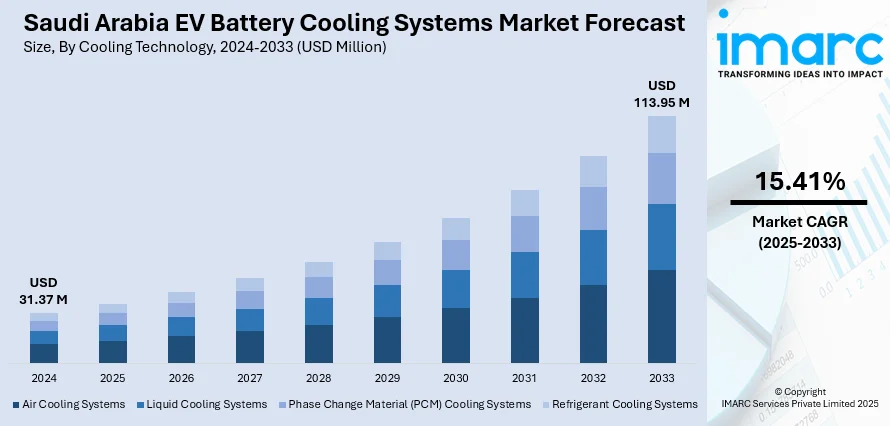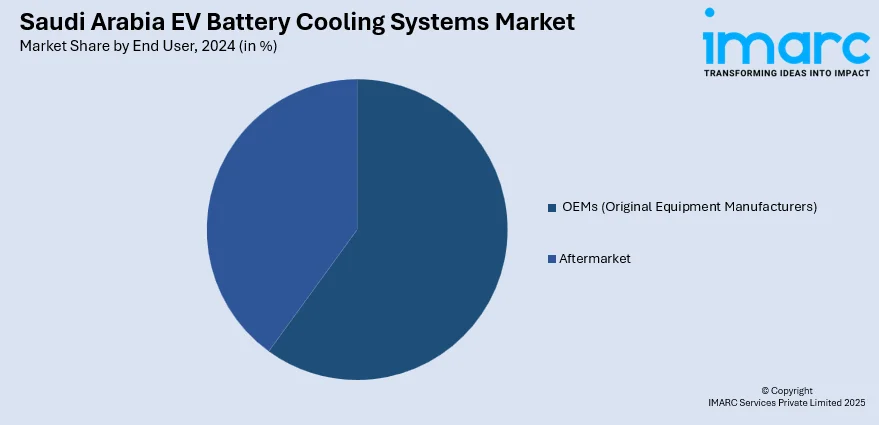
Saudi Arabia EV Battery Cooling Systems Market Size, Share, Trends and Forecast by Cooling Technology, Battery Type, Vehicle Type, Propulsion Type, End User, and Region, 2025-2033
Saudi Arabia EV Battery Cooling Systems Market Overview:
The Saudi Arabia EV battery cooling systems market size reached USD 31.37 Million in 2024. Looking forward, IMARC Group expects the market to reach USD 113.95 Million by 2033, exhibiting a growth rate (CAGR) of 15.41% during 2025-2033. The market is driven by Vision 2030’s push for electric mobility, increasing demand for high-efficiency liquid cooling systems to combat extreme temperatures and ensure battery safety. Government-led localization efforts and global partnerships are accelerating domestic production of advanced cooling technologies, reducing costs and enhancing supply chain resilience. Growing investments in EV infrastructure and R&D further augment the Saudi Arabia EV battery cooling systems market share.
|
Report Attribute
|
Key Statistics
|
|---|---|
|
Base Year
|
2024
|
|
Forecast Years
|
2025-2033
|
|
Historical Years
|
2019-2024
|
| Market Size in 2024 | USD 31.37 Million |
| Market Forecast in 2033 | USD 113.95 Million |
| Market Growth Rate 2025-2033 | 15.41% |
Saudi Arabia EV Battery Cooling Systems Market Trends:
Rising Demand for Advanced Liquid Cooling Systems in Saudi Arabia’s EV Market
The market is witnessing a rise in demand for advanced liquid cooling solutions. As the country accelerates its shift toward electric mobility under Vision 2030, automakers and battery manufacturers are prioritizing efficient thermal management to enhance battery performance and longevity. As per a 2024 survey, roughly 70 percent of drivers in Saudi Arabia are interested in battery-electric vehicles (BEVs) at present, and an estimated 85 percent of drivers in Saudi Arabia will continue preferring BEVs until the year 2035. Saudi consumers exhibit the highest global awareness of Chinese electric vehicle brands at 93%, in addition to possessing the largest number of Saudi participants who are stated to be accepting of a worldwide plug-in hybrid electric vehicle (PHEV). Electric vehicles have been propelling a steady rise in demand for EV battery cooling systems, which is central to the development of smart mobility in harmony with Vision 2030. Liquid cooling systems, known for their superior heat dissipation capabilities, are increasingly preferred over traditional air-cooled systems, especially for high-performance and long-range EVs. The extreme climatic conditions in Saudi Arabia further amplify the need for robust cooling solutions to prevent battery overheating and ensure safety. Additionally, government initiatives promoting local EV production and partnerships with global technology providers are driving innovation in liquid cooling systems. Moreover, increasing investments in EV infrastructure, including charging networks is also significantly supporting the Saudi Arabia EV battery cooling systems market growth.

Growth of Local Manufacturing and Partnerships in EV Battery Cooling Technologies
Saudi Arabia is focusing on localizing EV component production, including battery cooling systems, to reduce dependency on imports and strengthen its automotive supply chain. Saudi Arabia is making substantial investments in electric vehicle production with a vision to produce over 300,000 EVs a year by 2030 under its Vision 2030 diversification program. The Kingdom's initiatives include the local manufacturing of EV components, facilitated by the Public Investment Fund, which is supporting projects such as Lucid Motors' new plant in King Abdullah Economic City. This growth in electric vehicle production presents significant opportunities for suppliers locally in areas such as battery cooling systems and automotive infrastructure. The government’s push for domestic manufacturing under Vision 2030 has attracted global cooling system providers to establish joint ventures with Saudi firms. This trend is fostering technological advancements, such as phase-change materials and direct cooling systems, tailored to the region’s high-temperature environment. Additionally, partnerships between Saudi universities and international research institutions are accelerating R&D in next-generation cooling solutions. As local production scales up, costs are expected to decrease, making EVs more affordable for consumers. With Saudi Arabia positioning itself as a regional EV hub, the domestic battery cooling systems market is poised for substantial growth, supported by policy incentives and increasing consumer adoption of electric vehicles.
Saudi Arabia EV Battery Cooling Systems Market Segmentation:
IMARC Group provides an analysis of the key trends in each segment of the market, along with forecasts at the country and regional levels for 2025-2033. Our report has categorized the market based on cooling technology, battery type, vehicle type, propulsion type, and end user.
Cooling Technology Insights:
- Air Cooling Systems
- Liquid Cooling Systems
- Phase Change Material (PCM) Cooling Systems
- Refrigerant Cooling Systems
The report has provided a detailed breakup and analysis of the market based on the cooling technologies. This includes air cooling systems, liquid cooling systems, phase change material (PCM) cooling systems, and refrigerant cooling systems.
Battery Type Insights:
- Lithium-Ion Batteries
- Nickel-Metal Hydride Batteries
- Solid-State Batteries
- Others
A detailed breakup and analysis of the market based on the battery type have also been provided in the report. This includes lithium-ion batteries, nickel-metal hydride batteries, solid-state batteries, and others.
Vehicle Type Insights:
- Passenger Vehicles
- Commercial Vehicles
- Two-Wheelers
- Three-Wheelers
The report has provided a detailed breakup and analysis of the market based on the vehicle type. This includes passenger vehicles, commercial vehicles, two-wheelers, and three-wheelers.
Propulsion Type Insights:
- Battery Electric Vehicles (BEVs)
- Plug-in Hybrid Electric Vehicles (PHEVs)
- Hybrid Electric Vehicles (HEVs)
A detailed breakup and analysis of the market based on the propulsion type have also been provided in the report. This includes battery electric vehicles (BEVs), plug-in hybrid electric vehicles (PHEVs), and hybrid electric vehicles (HEVs).
End User Insights:

- OEMs (Original Equipment Manufacturers)
- Aftermarket
The report has provided a detailed breakup and analysis of the market based on the end user. This includes OEMs (Original Equipment Manufacturers) and aftermarket.
Regional Insights:
- Northern and Central Region
- Western Region
- Eastern Region
- Southern Region
The report has also provided a comprehensive analysis of all the major regional markets, which include Northern and Central Region, Western Region, Eastern Region, and Southern Region.
Competitive Landscape:
The market research report has also provided a comprehensive analysis of the competitive landscape. Competitive analysis such as market structure, key player positioning, top winning strategies, competitive dashboard, and company evaluation quadrant has been covered in the report. Also, detailed profiles of all major companies have been provided.
Saudi Arabia EV Battery Cooling Systems Market News:
- May 05, 2025: Lucid Group unveiled a strategic partnership with King Abdullah University of Science and Technology (KAUST) to develop electric vehicle (EV) technology further, focusing on advanced battery systems, powertrains, and cool solutions. The partnership will draw upon KAUST's supercomputing capabilities to enhance material science and thermal management, which are critical to optimizing EV battery performance. This collaboration is aligned with Saudi Arabia's Vision 2030, under which the nation aims to become a world leader in sustainable mobility.
Saudi Arabia EV Battery Cooling Systems Market Report Coverage:
| Report Features | Details |
|---|---|
| Base Year of the Analysis | 2024 |
| Historical Period | 2019-2024 |
| Forecast Period | 2025-2033 |
| Units | Million USD |
| Scope of the Report |
Exploration of Historical Trends and Market Outlook, Industry Catalysts and Challenges, Segment-Wise Historical and Future Market Assessment:
|
| Cooling Technologies Covered | Air Cooling Systems, Liquid Cooling Systems, Phase Change Material (PCM) Cooling Systems, Refrigerant Cooling Systems |
| Battery Types Covered | Lithium-Ion Batteries, Nickel-Metal Hydride Batteries, Solid-State Batteries, Others |
| Vehicle Types Covered | Passenger Vehicles, Commercial Vehicles, Two-Wheelers, Three-Wheelers |
| Propulsion Types Covered | Battery Electric Vehicles (BEVs), Plug-in Hybrid Electric Vehicles (PHEVs), Hybrid Electric Vehicles (HEVs) |
| End Users Covered | OEMs (Original Equipment Manufacturers), Aftermarket |
| Regions Covered | Northern and Central Region, Western Region, Eastern Region, Southern Region |
| Customization Scope | 10% Free Customization |
| Post-Sale Analyst Support | 10-12 Weeks |
| Delivery Format | PDF and Excel through Email (We can also provide the editable version of the report in PPT/Word format on special request) |
Key Questions Answered in This Report:
- How has the Saudi Arabia EV battery cooling systems market performed so far and how will it perform in the coming years?
- What is the breakup of the Saudi Arabia EV battery cooling systems market on the basis of cooling technology?
- What is the breakup of the Saudi Arabia EV battery cooling systems market on the basis of battery type?
- What is the breakup of the Saudi Arabia EV battery cooling systems market on the basis of vehicle type?
- What is the breakup of the Saudi Arabia EV battery cooling systems market on the basis of propulsion type?
- What is the breakup of the Saudi Arabia EV battery cooling systems market on the basis of end user?
- What is the breakup of the Saudi Arabia EV battery cooling systems market on the basis of region?
- What are the various stages in the value chain of the Saudi Arabia EV battery cooling systems market?
- What are the key driving factors and challenges in the Saudi Arabia EV battery cooling systems market?
- What is the structure of the Saudi Arabia EV battery cooling systems market and who are the key players?
- What is the degree of competition in the Saudi Arabia EV battery cooling systems market?
Key Benefits for Stakeholders:
- IMARC’s industry report offers a comprehensive quantitative analysis of various market segments, historical and current market trends, market forecasts, and dynamics of the Saudi Arabia EV battery cooling systems market from 2019-2033.
- The research report provides the latest information on the market drivers, challenges, and opportunities in the Saudi Arabia EV battery cooling systems market.
- Porter's five forces analysis assist stakeholders in assessing the impact of new entrants, competitive rivalry, supplier power, buyer power, and the threat of substitution. It helps stakeholders to analyze the level of competition within the Saudi Arabia EV battery cooling systems industry and its attractiveness.
- Competitive landscape allows stakeholders to understand their competitive environment and provides an insight into the current positions of key players in the market.
Need more help?
- Speak to our experienced analysts for insights on the current market scenarios.
- Include additional segments and countries to customize the report as per your requirement.
- Gain an unparalleled competitive advantage in your domain by understanding how to utilize the report and positively impacting your operations and revenue.
- For further assistance, please connect with our analysts.
 Request Customization
Request Customization
 Speak to an Analyst
Speak to an Analyst
 Request Brochure
Request Brochure
 Inquire Before Buying
Inquire Before Buying




.webp)




.webp)












